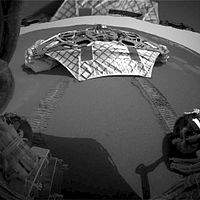Hazcam

Hazcam (zkratka Hazard Avoidance Cameras) jsou fotografické kamery umístěné vpředu a vzadu na vozítkách společnosti NASA – Spirit, Opportunity, Curiosity a Perseverance účastnící se misí na planetu Mars.
Popis
Zařízení Hazcam je citlivé na viditelné světlo a snímá černobílé fotografie o rozlišení 1024x1024 pixelů. Tyto záběry jsou využívány interním počítačem vozítka k samostatné navigaci v nebezpečných situacích. Díky jejich umístění na obou stranách vozítka a simultánnímu snímání vpředu a vzadu poskytují podklady pro trojrozměrné mapování bezprostředního okolí. V důsledku toho, že kamery jsou fixovány napevno (nepohybují se samostatně, ale s vozítkem), disponují širokým úhlem pohledu (přibližně 120° horizontálně i vertikálně) a poskytují záběr na velký prostor terénu.
Kamery jsou považovány za technické kamery, protože nebyly určeny k použití pro vědecké experimenty. Další sada inženýrských kamer na vozítkách jsou takzvané Navcamy.
Vozítko Mars Exploration Rover má pod úrovní paluby umístěny dva páry kamer HazCam (jeden pár vpředu a jeden vzadu), které zajišťují sledování terénních překážek při pohybu vozítka. Právě zařízení Hazcam potvrdilo bezpečné přistání Mars Science Laboratory.
Galerie
- Uvíznutí vozítka Mars Exploration Rover Opportunity v měkké písečné duně. Sekvence začíná 460. den na Marsu (10. května 2005) a končí o 11 dnů později. Robot za tu dobu popojel o 26 cm, zatímco se kolečko otočilo tolikrát, že by na pevném podkladu ujelo 46 metrů. Záběr z pravé přední kamery.
- Robot Opportunity se vzdaluje od svého přistávacího modulu. Je vidět konzistentní povrch Marsu, 27. března 2004.
- Fotografie pořízená vozítkem Opportunity ukazuje, jak robot zajel do velmi měkkého materiálu a do poloviny kola zapadl, 26. dubna 2005, Sol 446
- Robotická paže Opportunity zkoumá horninu, 21. ledna 2005
Odkazy
Související články
- Curiosity rover
- Mars (planeta)
Externí odkazy
 Obrázky, zvuky či videa k tématu Hazcam na Wikimedia Commons
Obrázky, zvuky či videa k tématu Hazcam na Wikimedia Commons - NASA page detailing the rovers' "senses" Archivováno 5. 4. 2005 na Wayback Machine.
- Mars Exploration Rover Technical Data
Média použitá na této stránce
NASA's Hubble Space Telescope took the picture of Mars on June 26, 2001, when Mars was approximately 68 million kilometers (43 million miles) from Earth — the closest Mars has ever been to Earth since 1988. Hubble can see details as small as 16 kilometers (10 miles) across. The colors have been carefully balanced to give a realistic view of Mars' hues as they might appear through a telescope. Especially striking is the large amount of seasonal dust storm activity seen in this image. One large storm system is churning high above the northern polar cap (top of image), and a smaller dust storm cloud can be seen nearby. Another large dust storm is spilling out of the giant Hellas impact basin in the Southern Hemisphere (lower right).
The right front wheel of NASA's Mars Exploration Rover Opportunity makes slow but steady progress through soft dune material in this movie clip of frames taken by the rover's front hazard identification camera over a period of several days. The sequence starts on Opportunity's 460th martian day, or sol (May 10, 2005) and ends 11 days later. In eight drives during that period, Opportunity advanced a total of 26 centimeters (10 inches) while spinning its wheels enough to have driven 46 meters (151 feet) if there were no slippage. The motion appears to speed up near the end of the clip, but that is an artifact of individual frames being taken less frequently.
1ers tours de roue du robot Opportunity sur Mars, qui s'éloigne de son atterrisseur : on peut remarquer la consistante très poudreuse du sol martien.
The dug-in back wheels of the Opportunity rover. Left Rear Hazard Camera Non-linearized Full frame EDR acquired on Sol 468 of Opportunity's mission to Meridiani Planum at approximately 15:34:38 Mars local solar time.
Mars rover Opportunity examines en:Heat Shield Rock on Sol 349 of its mission, at approximately 13:27:37 Mars local solar time. Left Front Hazard Camera Non-linearized Downsampled EDR acquired on Sol 349 of Opportunity's mission to Meridiani Planum at approximately 13:27:37 Mars local solar time.
Photo taken by the Mars Exploration Rover Opportunity on mission sol 446 of its tracks on Mars. This shows how Opporunity drove into very soft material and became entrenched halfway up the wheels.









